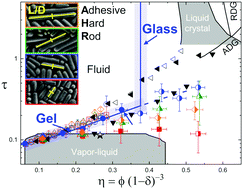当前位置:
X-MOL 学术
›
Soft Matter
›
论文详情
Our official English website, www.x-mol.net, welcomes your feedback! (Note: you will need to create a separate account there.)
Dynamic arrest of adhesive hard rod dispersions.
Soft Matter ( IF 3.4 ) Pub Date : 2020-01-08 , DOI: 10.1039/c9sm01877h Ryan P Murphy 1 , Harold W Hatch , Nathan A Mahynski , Vincent K Shen , Norman J Wagner
Soft Matter ( IF 3.4 ) Pub Date : 2020-01-08 , DOI: 10.1039/c9sm01877h Ryan P Murphy 1 , Harold W Hatch , Nathan A Mahynski , Vincent K Shen , Norman J Wagner
Affiliation

|
The phenomenon of dynamic arrest, more commonly referred to as gel and glass formation, originates as particle motion slows significantly. Current understanding of gels and glasses stems primarily from dispersions of spherical particles, but much less is known about how particle shape affects dynamic arrest transitions. To better understand the effects of particle shape anisotropy on gel and glass formation, we systematically measure the rheology, particle dynamics, and static microstructure of thermoreversible colloidal dispersions of adhesive hard rods (AHR). First, the dynamic arrest transitions are mapped as a function of temperature T, aspect ratio L/D≈ 3 to 7, and volume fraction φ≈ 0.1 to 0.5. The critical gel temperature Tgel and glass volume fraction φg are determined from the particle dynamics and rheology. Second, an effective orientation-averaged, short-range attraction between rods is quantified from small-angle scattering measurements and characterized by a reduced temperature τ. Similar τ is found at low rod concentrations, indicating that rod gelation occurs at similar effective attraction strength independent of L/D. Monte Carlo simulations reveal a similar convergence in τ when rods cluster and percolate with an average bond coordination number 〈nc〉≈ 2.4, supporting the link between physical gelation and rigidity percolation. Lastly, AHR results are mapped onto a dimensionless state diagram to compare with previous predictions of attraction-driven gels, repulsion-driven glasses, and liquid crystal phases.
中文翻译:

动态阻滞硬质棒状分散体。
动态停止现象(通常称为凝胶和玻璃形成)源自粒子运动明显减慢。当前对凝胶和玻璃的理解主要源于球形颗粒的分散,但对颗粒形状如何影响动态阻滞转变的了解还很少。为了更好地理解颗粒形状各向异性对凝胶和玻璃形成的影响,我们系统地测量了硬质棒(AHR)的热可逆胶体分散体的流变性,颗粒动力学和静态微观结构。首先,将动态停滞转变映射为温度T,纵横比L /D≈3至7和体积分数φ≈0.1至0.5的函数。临界凝胶温度Tgel和玻璃体积分数φg由颗粒动力学和流变性确定。第二,通过小角度散射测量可量化杆之间有效的方向平均短程吸引力,并以降低的温度τ为特征。在低棒浓度下发现相似的τ,表明棒胶凝在相似的有效吸引强度下发生,与L / D无关。蒙特卡洛模拟显示,当棒聚集和渗入时,平均键配位数〈nc〉≈2.4时,τ的收敛性相似,这支持了物理胶凝和刚性渗滤之间的联系。最后,将AHR结果映射到无量纲状态图上,以与吸引驱动的凝胶,排斥驱动的玻璃和液晶相的先前预测进行比较。在低棒浓度下发现相似的τ,表明棒胶凝在相似的有效吸引强度下发生,与L / D无关。蒙特卡洛模拟显示,当棒聚集和渗入时,平均键配位数〈nc〉≈2.4时,τ的收敛性相似,这支持了物理胶凝和刚性渗滤之间的联系。最后,将AHR结果映射到无量纲状态图上,以与吸引驱动的凝胶,排斥驱动的玻璃和液晶相的先前预测进行比较。在低棒浓度下发现相似的τ,表明棒胶凝在相似的有效吸引强度下发生,与L / D无关。蒙特卡洛模拟显示,当棒聚集和渗入时,平均键配位数〈nc〉≈2.4时,τ的收敛性相似,这支持了物理胶凝和刚性渗滤之间的联系。最后,将AHR结果映射到无量纲状态图上,以与吸引驱动的凝胶,排斥驱动的玻璃和液晶相的先前预测进行比较。支持物理胶凝和刚性渗透之间的联系。最后,将AHR结果映射到无量纲状态图上,以与吸引驱动的凝胶,排斥驱动的玻璃和液晶相的先前预测进行比较。支持物理胶凝和刚性渗透之间的联系。最后,将AHR结果映射到无量纲状态图上,以与吸引驱动的凝胶,排斥驱动的玻璃和液晶相的先前预测进行比较。
更新日期:2020-02-13
中文翻译:

动态阻滞硬质棒状分散体。
动态停止现象(通常称为凝胶和玻璃形成)源自粒子运动明显减慢。当前对凝胶和玻璃的理解主要源于球形颗粒的分散,但对颗粒形状如何影响动态阻滞转变的了解还很少。为了更好地理解颗粒形状各向异性对凝胶和玻璃形成的影响,我们系统地测量了硬质棒(AHR)的热可逆胶体分散体的流变性,颗粒动力学和静态微观结构。首先,将动态停滞转变映射为温度T,纵横比L /D≈3至7和体积分数φ≈0.1至0.5的函数。临界凝胶温度Tgel和玻璃体积分数φg由颗粒动力学和流变性确定。第二,通过小角度散射测量可量化杆之间有效的方向平均短程吸引力,并以降低的温度τ为特征。在低棒浓度下发现相似的τ,表明棒胶凝在相似的有效吸引强度下发生,与L / D无关。蒙特卡洛模拟显示,当棒聚集和渗入时,平均键配位数〈nc〉≈2.4时,τ的收敛性相似,这支持了物理胶凝和刚性渗滤之间的联系。最后,将AHR结果映射到无量纲状态图上,以与吸引驱动的凝胶,排斥驱动的玻璃和液晶相的先前预测进行比较。在低棒浓度下发现相似的τ,表明棒胶凝在相似的有效吸引强度下发生,与L / D无关。蒙特卡洛模拟显示,当棒聚集和渗入时,平均键配位数〈nc〉≈2.4时,τ的收敛性相似,这支持了物理胶凝和刚性渗滤之间的联系。最后,将AHR结果映射到无量纲状态图上,以与吸引驱动的凝胶,排斥驱动的玻璃和液晶相的先前预测进行比较。在低棒浓度下发现相似的τ,表明棒胶凝在相似的有效吸引强度下发生,与L / D无关。蒙特卡洛模拟显示,当棒聚集和渗入时,平均键配位数〈nc〉≈2.4时,τ的收敛性相似,这支持了物理胶凝和刚性渗滤之间的联系。最后,将AHR结果映射到无量纲状态图上,以与吸引驱动的凝胶,排斥驱动的玻璃和液晶相的先前预测进行比较。支持物理胶凝和刚性渗透之间的联系。最后,将AHR结果映射到无量纲状态图上,以与吸引驱动的凝胶,排斥驱动的玻璃和液晶相的先前预测进行比较。支持物理胶凝和刚性渗透之间的联系。最后,将AHR结果映射到无量纲状态图上,以与吸引驱动的凝胶,排斥驱动的玻璃和液晶相的先前预测进行比较。


























 京公网安备 11010802027423号
京公网安备 11010802027423号